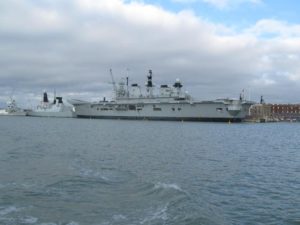Yeats's image of heroic sacrifice seems appropriate also for the once-tall ships of Portsmouth Historic Dockyard. It is particularly apt for its most famous hero: Nelson.
Each vessel on display provides an intense experience for all ages. The three together can be overwhelming. This is not to warn against a full visit though it can be strenuous. They are not all fully accessible for those with restricted mobility. Whether for a single visit or, if you can return, the "all attractions" ticket, better than a 3 for 2 offer, is valid for twelve months and includes a fascinating harbour cruise.
We took our eight-year-old granddaughter. To guard against stamina problems we fortified her with a panini and fruit drink and offered the choice of route. Our only proviso was that the cruise came last so we could meet our car near Gunwharf Quay.
Was it the "Terrible Tudors" and memories of school projects or the magic of "Mary Rose" that persuaded her to travel back through time? It worked for her and for us too. Both young and old can appreciate the progressively more primitive past times at sea. Examples are the surgical instruments, gruesome enough in the Victorian Warrior, though she never fired a shot in anger, graphically so recalling how men suffered in battle aboard Victory, and vivdly re-enacted as though aboard Mary Rose.
Who can fail to be moved by the simple brass plaque where Nelson fell or the reconstructed archer of Mary Rose beside his skeleton? There are the grim cells for miscreants aboard Warrior, wooden bunks with a block for pillow, and – fascinating to children – oakum picking as punishment, although below-decks conditions without punishment on Victory were as bad, and on Mary Rose unbelievably hard.
Officers of course lived a life (almost) apart: there is the Downton Abbey at sea luxury of the wardroom table on Warrior, with silver and cut glass, only a little less so on Victory, though with Nelson's state rooms enviable in any situation. By contrast, the Tudor officer grinding his precious single pepper corn on to the pheasant killed by his pet falcon may be re-created but the evidence is alongside as proof. Each ship is a time capsule although Mary Rose, as one book title has it, is "Sealed by Time".
For all ages the cooking facilities are to be wondered at. First, the very fact of using fire on a timber ship; second, the size of the cauldron on Mary Rose and the splendid gleaming copper in the two later galleys; third, the range of food available. Evidence is there in all: excavated in Mary Rose, reconstructed in the others, with a week's menu and sick bay provisions on Warrior as well as its labelled containers.
Only Warrior was steam powered of course, and despite her peaceful existence the stoke hole created vividly for me what my grandfather must have endured at the battle of Jutland, half a century later. The slowly turning engines were by contrast peaceful.
The entire Dockyard complex, including the exhibits we did not have time to visit, the dry dock constructed by Napoleonic War prisoners and recently used in the film "Les Miserables", not to mention all the serving or redundant modern vessels in harbour, seen on the cruise, is stirring. Nothing is more so, however, than to think of almost 400 men and boys drowned aboard Mary Rose. These are in a sense all brought back to life in the elegant building that encloses the remains of their ship. You can try your strength with a long bow, touch and smell retrieved materials, and reflect on the number of rosaries and other signs of Roman Catholicism carried aboard almost a decade after the English Reformation.
For mundane needs there is a cafe at the Dockyard entrance, two other places to eat between the ticket office and Victory, and a good one (where we recharged energies before the visit) in the Mary Rose museum.
The process of drying out the timbers of the Mary Rose is due to be completed in a year or two. Then it will be possible to view the remains without their assorted pipes and cables. I'll be sure to go back then.









